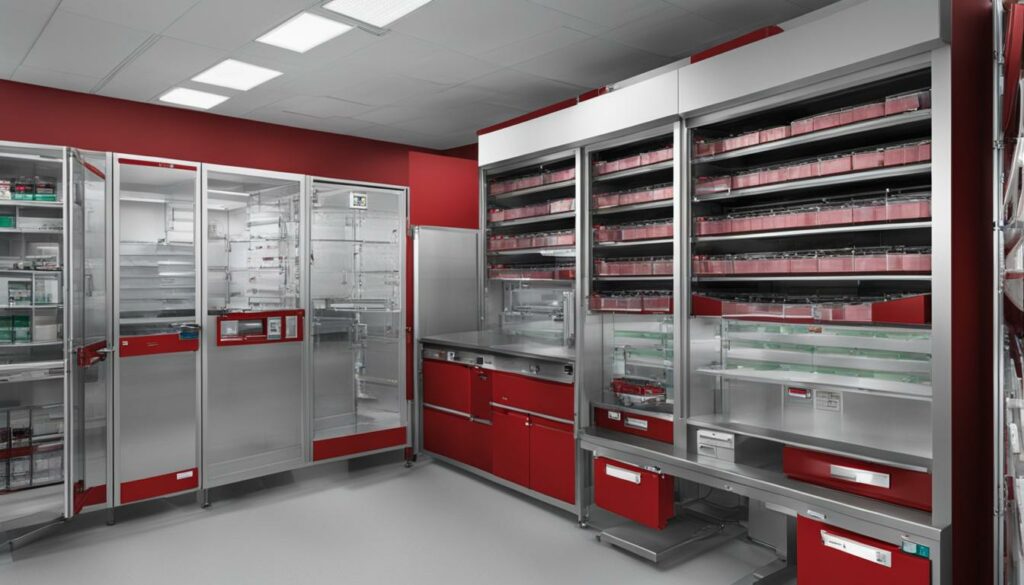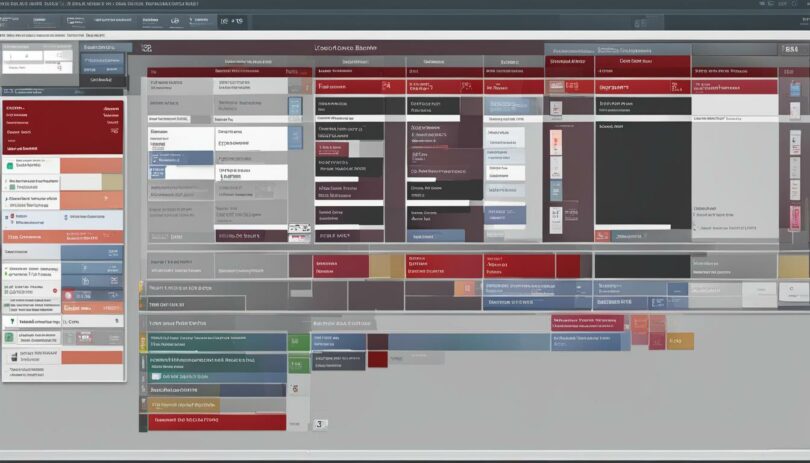Blood bank management software is a vital tool for blood banks to effectively manage their operations and ensure the safety and compliance of their processes. With the use of efficient software, blood banks can streamline their workflows, reduce errors, and ultimately enhance patient safety. In this article, we will explore the key features and benefits of blood bank management software, highlighting its importance in the healthcare industry.
Key Takeaways:
- Blood bank management software is essential for ensuring safety and compliance in blood banking operations.
- Streamlining workflows and ensuring compliance are key benefits of using blood bank management software.
- Real-time data monitoring enhances patient safety and ensures adherence to protocols.
- Blood bank management software offers comprehensive support and training for staff members.
- Data security measures are implemented to protect confidential patient and donor information.
The Importance of Blood Bank Management Software
Blood bank management software plays a crucial role in the effective functioning of blood banks. It provides a centralized platform for managing various aspects of blood banking, including donor screening, inventory management, and transfusion tracking. With the right software solutions, blood banks can enhance their operations, ensure efficient blood donation processes, and maintain accurate records of blood inventory.
One of the key benefits of utilizing blood bank management software is the ability to streamline workflows. The software allows blood banks to automate processes, reducing the need for manual interventions and minimizing the risk of errors. By having a centralized system for managing donor information and blood inventory, blood banks can improve efficiency and reduce the time spent on administrative tasks.
Another advantage of blood bank management software is its ability to ensure compliance with regulatory requirements. The software provides standardized processes and documentation, helping blood banks maintain accurate records and meet legal obligations. By adhering to these standards, blood banks can enhance patient safety and trust, while also avoiding potential penalties or legal issues.
Table: Key Features of Blood Bank Management Software
| Features | Description |
|---|---|
| Donor screening | Automated screening processes to identify eligible blood donors |
| Inventory management | Real-time tracking of blood inventory levels and expiration dates |
| Transfusion tracking | Traceability of blood products from collection to transfusion |
| Electronic database management | Centralized storage and easy access to donor and patient information |
| Standardized processes and documentation | Ensuring compliance with regulatory requirements |
| Data security | Robust measures to protect confidential patient and donor information |
By leveraging the benefits of blood bank management software, blood banks can optimize their operations, improve patient safety, and provide the highest level of care to those in need. With features such as donor screening, inventory management, and transfusion tracking, the software enables blood banks to streamline processes, enhance efficiency, and maintain accurate records. This ensures that blood banks can effectively manage their resources, comply with regulations, and ultimately save more lives.
Streamlining Workflows and Ensuring Compliance
Blood bank management software plays a crucial role in streamlining workflows and ensuring compliance within blood banks. By implementing efficient software solutions, blood banks can optimize their operations, improve productivity, and maintain regulatory requirements. The use of blood bank database software, blood inventory management software, and blood tracking software enables blood banks to effectively manage their processes, from donor screening to transfusion tracking.
One of the key features of blood bank management software is the electronic database management capability. This allows blood banks to store and access crucial information about donors, blood products, and transfusions in a centralized and secure database. By having all data in one place, blood banks can easily track and monitor blood products, reducing the risk of errors and ensuring accurate inventory management.
In addition to database management, blood bank management software also offers automated inventory tracking and real-time monitoring of blood products. These features enhance the efficiency of blood banks by reducing manual errors, improving supply chain management, and minimizing wastage. Blood banks can track the movement of blood products from the point of donation to transfusion, ensuring proper handling, storage, and utilization.
To comply with regulatory requirements, blood bank management software provides standardized processes and documentation. This ensures that blood banks follow industry best practices and adhere to safety protocols. By having a structured system in place, blood banks can easily generate reports, maintain audit trails, and demonstrate compliance during regulatory inspections.
Benefits of Streamlining Workflows and Ensuring Compliance
- Improved efficiency: Streamlined workflows and automated processes reduce manual errors, saving time and effort for blood bank staff.
- Enhanced patient safety: Accurate inventory management and real-time tracking of blood products ensure that safe and compatible blood is available for transfusions.
- Effective compliance management: Standardized processes and documentation help blood banks comply with regulatory requirements, minimizing the risk of penalties or sanctions.
- Optimized resource utilization: Automated inventory tracking and wastage reduction strategies improve the efficient use of blood products, minimizing costs and maximizing availability.
By implementing blood bank management software, blood banks can streamline their workflows, ensure compliance, and enhance patient safety. The use of efficient database management, inventory tracking, and real-time monitoring features enable blood banks to operate more efficiently and effectively. By investing in the right software solutions, blood banks can optimize their operations and provide the highest level of care to patients in need.
Enhancing Patient Safety with Real-Time Data Monitoring
When it comes to blood bank management, patient safety is of utmost importance. That’s why having a reliable and efficient blood bank management solution is crucial. One important feature that such a solution should offer is real-time data monitoring. This feature allows blood banks to track the journey of each blood product, from donor screening to transfusion, ensuring that all necessary protocols are followed and that the blood is safe for patients.
By monitoring data in real-time, potential issues or discrepancies can be identified promptly, minimizing the risk of errors or adverse events. For example, if a blood product has not been properly stored or has expired, the real-time monitoring system will immediately detect it, allowing for immediate action to address the issue. This proactive approach significantly enhances patient safety and ensures that only safe and suitable blood products are used for transfusions.
Benefits of Real-Time Data Monitoring:
- Immediate identification of potential issues or discrepancies
- Prompt action to address issues, minimizing patient risk
- Enhanced accuracy in tracking blood products
- Improved overall quality control
Real-time data monitoring is a powerful tool that empowers blood banks with the ability to ensure the safety and well-being of their patients. By investing in a comprehensive blood bank management solution with this feature, blood banks can provide the highest level of care and peace of mind to both patients and healthcare professionals.

Table: Comparison of Real-Time Data Monitoring Features
| Feature | Standard Solution | Blood Bank Management Solution |
|---|---|---|
| Real-time monitoring | No | Yes |
| Immediate issue detection | No | Yes |
| Prompt action notification | No | Yes |
| Enhanced accuracy in tracking | No | Yes |
| Improved quality control | No | Yes |
As shown in the table above, a standard solution lacks the crucial real-time data monitoring feature that a blood bank management solution provides. With a blood bank management solution, blood banks can proactively monitor and address potential issues, ensuring patient safety and maintaining the highest standards of quality control.
Blood Bank Management Software: Comprehensive Support and Training for Blood Bank Staff
Blood bank management software providers understand the importance of ensuring that blood bank staff members are fully equipped to utilize the software’s features effectively. To facilitate this, they offer comprehensive support and training programs tailored for blood bank operations.
When implementing a blood bank management solution, the software provider’s support team plays a crucial role in assisting with software implementation, customization, and troubleshooting. They are there to guide blood bank staff through the entire process, ensuring a smooth transition and optimal utilization of the software.
In addition to support, training programs are also provided to train blood bank staff members on how to effectively use the software in their daily operations. These training programs cover various aspects of the software, including donor screening, inventory management, transfusion tracking, and other key features. By empowering staff with the necessary knowledge and skills, blood bank management software maximizes its potential to improve workflows and overall efficiency.
Key Benefits of Comprehensive Support and Training
- Efficient software implementation and customization
- Smooth transition to the new software
- Increased staff competency in utilizing the software
- Improved workflows and operational efficiency
“Implementing a blood bank management solution can be a significant change for a blood bank, but with the comprehensive support and training provided by the software provider, the transition becomes much smoother. Our staff members received in-depth training on how to utilize the software’s features effectively, enabling us to streamline our processes and enhance patient safety.” – Blood Bank Manager
Table: Training Modules Offered by Blood Bank Management Software Providers
| Training Module | Description |
|---|---|
| Donor Screening | Training on utilizing the software for thorough donor screening processes, ensuring the safety of blood products. |
| Inventory Management | Training on managing blood product inventory, including stock management, expiry tracking, and reordering. |
| Transfusion Tracking | Training on tracking and documenting blood product transfusion, ensuring accurate patient records and traceability. |
| Workflow Optimization | Training on streamlining workflows, utilizing automation features to minimize manual tasks and improve efficiency. |
| Software Customization | Training on customizing the software to fit the specific needs and processes of the blood bank. |
By providing comprehensive support and training, blood bank management software allows blood banks to optimize their operations and provide the highest level of care to patients in need.
Robust Data Security for Confidential Information
Blood bank management software prioritizes data security to protect confidential patient and donor information. The software includes robust security measures such as data encryption, user authentication, and access control. By implementing these security features, blood banks can safeguard sensitive data and maintain compliance with privacy regulations.
Data security is a critical aspect of blood bank management, as it involves handling sensitive information that must be kept confidential. With the increasing prevalence of cyber threats, blood banks need to ensure that their data is well-protected from unauthorized access or breaches. By utilizing a secure blood bank management solution, organizations can mitigate the risk of data breaches and maintain the trust of their patients and donors.
The implementation of data encryption is vital to ensure that any sensitive information stored in the blood bank management software remains secure. Encryption helps to convert data into unreadable ciphertext, making it difficult for unauthorized individuals to decipher. User authentication adds an extra layer of security by requiring authorized users to provide credentials such as usernames and passwords to access the system.
Access control plays a crucial role in managing the permissions and privileges of users within the blood bank management software. By defining user roles and access levels, blood banks can control who has the ability to view, edit, or delete specific data. This helps to prevent unauthorized access and ensures that confidential information is only accessible to authorized personnel.
| Key Features | Description |
| Data Encryption | Protects sensitive information by converting it into unreadable ciphertext |
| User Authentication | Requires authorized users to provide credentials for system access |
| Access Control | Manages user permissions and privileges to control data access |

Benefits of Robust Data Security in Blood Bank Management Software
- Protects confidential patient and donor information from unauthorized access
- Helps blood banks comply with privacy regulations and maintain data integrity
- Instills trust in patients and donors by demonstrating a commitment to data security
- Reduces the risk of data breaches and potential legal and financial consequences
“Data security is not just a compliance requirement; it is a fundamental responsibility of blood banks to protect the privacy and trust of their patients and donors. By investing in a robust blood bank management solution with strong security features, organizations can ensure that confidential information remains confidential and their operations continue to meet the highest standards of data protection.”
Scalable and Flexible Solutions for Blood Banks of all Sizes
Blood bank management software offers scalable and flexible solutions to meet the specific needs of blood banks, regardless of their size. Whether it’s a small community blood bank or a large-scale organization, the software can be tailored to accommodate the unique requirements of each institution.
These software solutions are designed to optimize workflows, enhance efficiency, and ensure seamless operations for blood banks. They provide centralized platforms for managing various aspects of blood banking, including donor screening, inventory management, and transfusion tracking.
With customizable features and modules, blood bank management software allows blood banks to adapt the software to their existing workflows and processes. This flexibility ensures that blood banks can effectively utilize the software to streamline their operations, reduce errors, and improve patient safety.
By choosing a scalable and flexible blood bank management software solution, blood banks can maximize their efficiency and provide the highest level of care to patients in need.
Blood Bank Software Solutions: Transparent Pricing with Justified ROI
Blood bank management software providers understand the importance of transparent pricing models that provide a clear understanding of the software’s cost and its return on investment (ROI). By offering transparent pricing, blood banks can make informed decisions regarding the implementation of blood bank software solutions. This transparency enhances financial planning and allows blood banks to allocate resources more effectively to optimize their operations.
With transparent pricing, blood banks can have a comprehensive view of the costs involved, including upfront costs, licensing fees, and ongoing maintenance fees. This clarity enables blood banks to factor in these costs and make informed decisions about budget allocation. By understanding the pricing structure, blood banks can evaluate the potential ROI and gauge the long-term benefits of implementing blood bank software solutions.
Furthermore, transparent pricing models help blood banks to assess the value and benefits they can expect from the software. By understanding the costs and the potential ROI, blood banks can analyze the financial impact of the software on their operations. This analysis can provide insights into potential cost savings, efficiency improvements, and patient safety enhancements that can be achieved by utilizing blood bank software solutions.
Ultimately, transparent pricing empowers blood banks to justify the investment in blood bank software solutions to key stakeholders, such as management, donors, and regulatory agencies. It facilitates open and informed discussions about the financial implications and benefits of implementing the software, ensuring that all parties involved have a clear understanding of the value proposition. This transparency contributes to a more efficient decision-making process and promotes the successful adoption of blood bank software solutions.
Transparent pricing models provide a clear understanding of the blood bank software’s cost and its return on investment (ROI), enabling blood banks to allocate resources effectively and make informed decisions.
Key Features of Blood Bank Management Software
Blood bank management software offers a wide range of key features that are essential for effective blood bank management. These features include:
- Equipment Management: The software allows blood banks to efficiently manage their equipment, ensuring proper maintenance and calibration. This reduces the risk of product defects and recalls, improving the overall quality of blood products.
- Quality Control: The software enables blood banks to implement consistent quality control measures, reducing the risk of errors and defects. This ensures that all blood products meet the required standards for safety and efficacy.
- Workflow Management: The software simplifies processes and increases efficiency by streamlining workflows. It reduces cycle times, improves communication among teams, and enhances productivity.
- Maintenance & Calibration: The software includes a dedicated module for streamlined equipment maintenance and calibration. It minimizes downtime, improves product quality, and maintains accurate records.
- Proficiency Testing: The software allows blood banks to conduct proficiency testing to assess the competency of their staff and ensure accurate test results.
- CAPA (Corrective and Preventive Actions): The software helps blood banks identify and address issues by implementing timely corrective and preventive actions.
- Non Conformance Management: The software manages non-conformances, ensuring that appropriate actions are taken to address deviations from established procedures.
- Document Control: The software provides a centralized platform for managing and controlling documents, ensuring that the most up-to-date versions are available to authorized personnel.
“Blood bank management software offers a wide range of key features that are essential for effective blood bank management.”
The software also includes features such as training management, competency assessment, deviation management, risk management, change management, validation management, audit management, supplier management, contract management, and reporting. These features further enhance the overall efficiency, compliance, and safety of blood bank operations.
Table: Key Features of Blood Bank Management Software
| Feature | Description |
|---|---|
| Equipment Management | Efficient management of blood bank equipment, ensuring proper maintenance and calibration. |
| Quality Control | Implementation of consistent quality control measures to reduce the risk of errors and defects. |
| Workflow Management | Streamlining of processes and increased efficiency through improved workflow management. |
| Maintenance & Calibration | Streamlined processes for equipment maintenance and calibration, minimizing downtime and improving product quality. |
| Proficiency Testing | Assessment of staff competency and accurate test results through proficiency testing. |
| CAPA (Corrective and Preventive Actions) | Identification and implementation of timely corrective and preventive actions to address issues. |
| Non Conformance Management | Management of non-conformances and appropriate actions for deviations from established procedures. |
| Document Control | Centralized platform for managing and controlling documents, ensuring up-to-date versions. |
Blood bank management software provides blood banks with comprehensive tools to manage their operations efficiently, maintain compliance, and ensure the safety and quality of blood products. By utilizing these key features, blood banks can improve their workflows, reduce errors, and enhance patient safety, ultimately providing the highest level of care to patients in need.
Effortlessly manage your equipment and ensure product quality
The equipment management module of blood bank management software provides a seamless solution for efficiently managing and maintaining crucial equipment in blood banks. By utilizing this module, blood banks can ensure that their equipment is properly calibrated, well-maintained, and functioning optimally, ultimately leading to improved product quality and patient safety.
This module allows blood banks to streamline their equipment management processes by providing features such as automated maintenance scheduling, calibration tracking, and equipment performance monitoring. It also enables blood banks to generate comprehensive reports on equipment usage, maintenance history, and calibration records, facilitating regulatory compliance and audits.
With the equipment management module, blood banks can easily track the status of each piece of equipment, schedule preventive maintenance tasks, and promptly address any issues that arise. This proactive approach helps minimize equipment downtime, reduce the risk of equipment failures, and enhance the overall efficiency of the blood bank.
Furthermore, the module enables blood banks to maintain an accurate inventory of equipment, ensuring that replacements or repairs can be planned and executed efficiently. By effectively managing their equipment, blood banks can provide a safe and reliable supply of blood products to meet the needs of patients, while also optimizing resource utilization and reducing costs.

Table: Key Features of the Equipment Management Module
| Feature | Description |
|---|---|
| Automated maintenance scheduling | Allows blood banks to schedule and track routine maintenance tasks for equipment. |
| Calibration tracking | Enables blood banks to record and monitor equipment calibration activities. |
| Equipment performance monitoring | Provides real-time monitoring of equipment performance to identify any abnormalities or deviations. |
| Comprehensive reporting | Generates detailed reports on equipment usage, maintenance history, and calibration records. |
| Inventory management | Allows blood banks to maintain an accurate inventory of equipment and track replacements or repairs. |
By utilizing the equipment management module of blood bank management software, blood banks can effectively manage their equipment, ensuring optimal performance, regulatory compliance, and the delivery of high-quality blood products to patients in need.
Reduce the Risk of Errors and Defects with Comprehensive Quality Control
Quality control is a critical aspect of blood bank management to ensure the safety and efficacy of blood products. Implementing comprehensive quality control measures is essential for reducing the risk of errors and defects in the blood banking process. Blood bank management software offers a dedicated quality control module that streamlines and enhances the quality control procedures in the blood bank.
With the quality control module, blood banks can establish standardized protocols for quality control checks at various stages, including donor screening, blood processing, and transfusion. The module allows for comprehensive monitoring of key quality indicators, such as temperature monitoring and testing for bacterial contamination. By closely monitoring these indicators, blood banks can identify and address any issues promptly, minimizing the risk of errors or defects in blood products.
The quality control module also facilitates efficient record keeping and documentation of quality control activities. It allows blood banks to generate detailed reports and track trends over time, enabling data-driven decision-making and continuous improvement of quality control practices. By leveraging the capabilities of the quality control module, blood banks can ensure that every blood product meets the required standards for safety and efficacy.
Benefits of the Quality Control Module:
- Standardized quality control protocols and procedures
- Comprehensive monitoring of key quality indicators
- Prompt identification and resolution of issues
- Efficient record keeping and documentation
- Data-driven decision-making and continuous improvement
By incorporating the quality control module into their blood bank management software, blood banks can significantly reduce the risk of errors and defects, ultimately enhancing the safety and quality of blood products.
Simplify workflows and increase efficiency with Workflow Management
The workflow management module of blood bank management software is a powerful tool that helps blood banks simplify their processes and increase overall efficiency. By automating and streamlining workflows, this module enables blood banks to optimize their operations, reduce manual errors, and improve communication and transparency among teams.
With the workflow management module, blood banks can design and customize workflows according to their specific needs and requirements. This ensures that each step in the process is clearly defined, assigned to the appropriate personnel, and completed within the designated timeframe. By eliminating manual handoffs and automating repetitive tasks, blood banks can save time, enhance productivity, and minimize the risk of errors.
The workflow management module also provides real-time visibility and tracking of each workflow, allowing blood bank staff to monitor progress and identify potential bottlenecks or delays. This information empowers managers to make data-driven decisions and take proactive measures to optimize workflow efficiency. By continuously monitoring and analyzing workflows, blood banks can identify areas for improvement, implement process enhancements, and ensure that operations run smoothly and efficiently.
Key Features of Workflow Management Module:
- Workflow design and customization
- Automated task assignment and tracking
- Real-time visibility and progress monitoring
- Alerts and notifications for pending tasks or delays
- Integration with other modules for seamless data flow
Implementing the workflow management module of blood bank management software can lead to significant improvements in operational efficiency and productivity. By simplifying workflows, automating tasks, and providing real-time visibility, blood banks can streamline their processes, reduce errors, and ensure that each step in the blood banking operation is completed efficiently and accurately.
Streamline Maintenance and Calibration with Dedicated Module
Effective maintenance and calibration of equipment is crucial for blood banks to ensure the accuracy and reliability of their operations. The maintenance and calibration module of blood bank management software provides a dedicated solution to streamline these processes and maintain optimal performance.
This module allows blood banks to schedule and track maintenance tasks, ensuring that equipment is regularly serviced and calibrated according to industry standards. By automating these processes, blood banks can minimize downtime, prevent equipment failures, and extend the lifespan of their valuable assets.
The maintenance and calibration module also enables blood banks to maintain comprehensive records of all maintenance activities, including calibration details and service history. This documentation is essential for regulatory compliance and audit purposes, showcasing the blood bank’s commitment to quality control and patient safety.
Benefits of the Maintenance and Calibration Module:
- Efficient scheduling and tracking of maintenance tasks
- Reduced downtime and equipment failures
- Extended equipment lifespan
- Comprehensive documentation for regulatory compliance
By utilizing the dedicated maintenance and calibration module of blood bank management software, blood banks can optimize their equipment maintenance processes, ensure accurate calibration, and enhance the overall efficiency of their operations.
| Benefits | Features |
|---|---|
| Efficient scheduling and tracking | Automated task management |
| Reduced downtime | Alerts and reminders for maintenance |
| Extended equipment lifespan | Regular service and calibration |
| Comprehensive documentation | Service history and calibration records |
Conclusion
Blood bank management software is a valuable tool for blood banks to ensure safety, compliance, and efficiency in their operations. With its comprehensive features and benefits, blood bank management software enables streamlined workflows, reduces errors, enhances patient safety, and improves overall productivity. By investing in the right blood bank management software, blood banks can optimize their operations and provide the highest level of care to patients in need.
FAQ
What is blood bank management software?
Blood bank management software is a specialized tool used by blood banks to manage various aspects of their operations, including donor screening, inventory management, and transfusion tracking. It helps streamline workflows, reduce errors, and improve patient safety.
How does blood bank management software enhance efficiency?
Blood bank management software offers features like electronic database management, automated inventory tracking, and real-time monitoring of blood products. These features help streamline workflows within the blood bank, leading to improved efficiency and productivity.
How does blood bank management software ensure compliance?
Blood bank management software provides standardized processes and documentation, helping blood banks comply with regulatory requirements. It also enables real-time data monitoring and analysis, ensuring that all necessary protocols are followed and the blood is safe for patients.
Does blood bank management software come with support and training?
Yes, blood bank management software providers typically offer dedicated support and training. Their support team assists with software implementation, customization, and troubleshooting. Training programs are also provided to train staff members on how to effectively use the software.
How does blood bank management software ensure data security?
Blood bank management software includes robust security measures such as data encryption, user authentication, and access control. These security features help safeguard sensitive patient and donor information and ensure compliance with privacy regulations.
Can blood bank management software be customized for different institutions?
Yes, blood bank management software is available in scalable and flexible options to cater to the specific needs of each blood bank, regardless of size. This flexibility allows institutions to adapt the software to their workflows effectively.
How can blood bank management software help with financial planning?
Blood bank management software providers offer transparent pricing models that provide a clear understanding of the software’s cost and return on investment. This helps blood banks allocate resources more effectively and make informed decisions regarding the implementation of the software.
What are the key features of blood bank management software?
Blood bank management software includes key features such as equipment management, quality control, workflow management, maintenance and calibration, proficiency testing, CAPA (Corrective and Preventive Actions), non-conformance management, document control, training management, competency assessment, deviation management, risk management, change management, validation management, audit management, supplier management, contract management, and reporting.
How does the equipment management module of blood bank management software benefit blood banks?
The equipment management module allows blood banks to efficiently manage their equipment, ensuring proper maintenance and calibration. This reduces the risk of product defects and recalls and improves the overall quality of blood products.
How does the quality control module of blood bank management software ensure product quality?
The quality control module enables blood banks to implement consistent quality control measures, reducing the risk of errors and defects. This ensures that all blood products meet the required standards for safety and efficacy.
How does the workflow management module of blood bank management software improve overall efficiency?
The workflow management module allows blood banks to simplify their processes, reducing cycle times and improving communication and transparency among teams. This leads to improved productivity and overall efficiency.
How does the maintenance and calibration module of blood bank management software streamline equipment management?
The maintenance and calibration module streamlines the processes involved in equipment maintenance and calibration. It minimizes downtime, improves product quality, and maintains accurate records of equipment maintenance.






